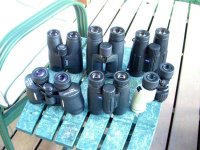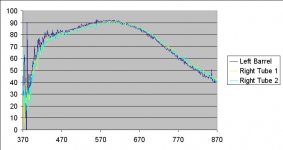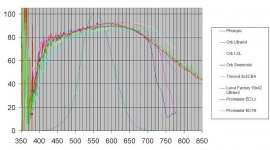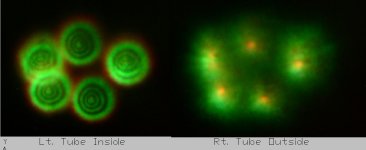FrankD
Well-known member
Yes, quite a mouthful but definitely worth it when your eyes are placed up against the eyepieces. 
I know this binocular has been discussed quite intensely under the "Mystery Binocular..." thread but I really feel the need to continue to draw attention to it simply because I continue to be impressed by its optical performance.
Really, it is that good.
After finally receiving my 8x32 Nikon SE this morning I have been sitting on the backporch shifting back and forth between the SE, the 7x42 Zeiss FL and the Promaster ED. Think this is an unfair comparison? Think again.
I spent alot of time last week comparing the image of the Promaster ED to the 8x32 Swarovski EL, the 8.5x42 EL and the 7x42 SLC. I came to the conclusion that the Promaster actually offered the best centerfield apparent sharpness of any of those models. Yes, you read that correctly. The image in the Promaster is exceptionally sharp. Granted both the ELs and the SLC had better edge performance. I have repeatedly compared the Promater to the FL in regards to this particular characteristic. Exceptional centerfield sharpness with a moderate level of astigmatism in the outer 1/3rd of the field of view. Because of the flatness of the image (no field curvature) the astigmatism isn't that troublesome though it does "turn your eye" towards the extremely sharp centerfield.
I have now been comparing the FL, SE and Promaster. In my opinion the centerfield apparent sharpness of the Promaster is very close, if not at the same level as the FL and SE.
I am not exaggerating in the least.
Edge performance is better in the SE and brightness is better in the FL but the Promaster really does compare very well optically to both of these models. Both the FL and SE display an extremely neutral color representation. Probably the most neutral of any binoculars I have had the privelege to look through. Only in comparison to these two models does the Promaster display an ever so slight warm color bias. To give you some perspective the Promaster looks entirely neutral in comparison to the ELs and SLCs. Flare control is also very good in the variety of conditions I have had the opportunity to place these binoculars in.
For those of you that have not been following the Mystery binocular thread the Promaster is now selling at several camera-specialty stores for $500 US and around $550 for the 10x42 model. (From my understanding Promaster only sells to these types of stores so those of you waiting for Eagle Optics or Cabelas to start carrying these may be waiting a long time.)
From an optical standpoint I do not really have anything negative to say about these bins. What I have found though is that when a person is really pleased with the optical package of a binocular then they start being really picky of the physical package...and vice versa. I guess it is just our nature to want to try for the "perfect binocular". In the case of the Promaster its physical characteristics and overall ergonomics are entirely acceptable. After intense use over the last two weeks I do not really have any "major" complaints in this regard.
On the minor side...
...the eyecups could be slightly more contoured and slightly stiffer in movement
...the focusing tension could be just a hair "tighter" as there is some play in my unit
...the diopter arrangment could be a little "classier" but is entirely adequate in its current design
The focusing speed is slow by todays standards requiring 2.5 turns to go from a close focus of 6 feet to infiniti. I have found this to actually be an asset though as it really gives me superior control in dialing in the sharpest image possible. The thumb indents on the underside of the barrel are fairly shallow but they fit my hands quite well. Placing my right thumb in the indent and allowing my left hand to wander further up the barrel, closer to the objective, produces an extremely stable platform while still allowing for perfect finger placement on the focusing knob.
All and all I am extremely satisfied with this binocular...excited even when you consider that you now can buy a Chinese manufactured binocular at the $500 price point that performs at this level.
Low light performance? Excellent
Apparent sharpness? Superb
Color representation? Very neutral
Brightness? Excellent
Handling? Very good
Its features read like a checklist.....
ED objectives....................check
Fully multicoated lenses......check
Phase coated prisms...........check
Silver coated prisms...........check
Waterproof.......................check
Nitrogen purged.................check
Close focusing...................check
Wide field of view...............check
Oil/water repellent coating...check
"No fault" warranty..............check
Average "high end" weight.....check
Good ergonomics..................check
I had the opportunity to compare the EDs against almost all of my bins last night....the Leupold Yosemite 8x30, Celestron Ultima DX 8x32, Bushnell Discoverer 7x42, Zeiss FL 7x42, Zeiss Conquest 8x30.....and really only the FLs displayed slightly better image quality. (see picture below)
I strongly encourage all of you binocular aficionados out there to give these binoculars a try. They are going to start gaining a following quickly.
I know this binocular has been discussed quite intensely under the "Mystery Binocular..." thread but I really feel the need to continue to draw attention to it simply because I continue to be impressed by its optical performance.
Really, it is that good.
After finally receiving my 8x32 Nikon SE this morning I have been sitting on the backporch shifting back and forth between the SE, the 7x42 Zeiss FL and the Promaster ED. Think this is an unfair comparison? Think again.
I spent alot of time last week comparing the image of the Promaster ED to the 8x32 Swarovski EL, the 8.5x42 EL and the 7x42 SLC. I came to the conclusion that the Promaster actually offered the best centerfield apparent sharpness of any of those models. Yes, you read that correctly. The image in the Promaster is exceptionally sharp. Granted both the ELs and the SLC had better edge performance. I have repeatedly compared the Promater to the FL in regards to this particular characteristic. Exceptional centerfield sharpness with a moderate level of astigmatism in the outer 1/3rd of the field of view. Because of the flatness of the image (no field curvature) the astigmatism isn't that troublesome though it does "turn your eye" towards the extremely sharp centerfield.
I have now been comparing the FL, SE and Promaster. In my opinion the centerfield apparent sharpness of the Promaster is very close, if not at the same level as the FL and SE.
I am not exaggerating in the least.
Edge performance is better in the SE and brightness is better in the FL but the Promaster really does compare very well optically to both of these models. Both the FL and SE display an extremely neutral color representation. Probably the most neutral of any binoculars I have had the privelege to look through. Only in comparison to these two models does the Promaster display an ever so slight warm color bias. To give you some perspective the Promaster looks entirely neutral in comparison to the ELs and SLCs. Flare control is also very good in the variety of conditions I have had the opportunity to place these binoculars in.
For those of you that have not been following the Mystery binocular thread the Promaster is now selling at several camera-specialty stores for $500 US and around $550 for the 10x42 model. (From my understanding Promaster only sells to these types of stores so those of you waiting for Eagle Optics or Cabelas to start carrying these may be waiting a long time.)
From an optical standpoint I do not really have anything negative to say about these bins. What I have found though is that when a person is really pleased with the optical package of a binocular then they start being really picky of the physical package...and vice versa. I guess it is just our nature to want to try for the "perfect binocular". In the case of the Promaster its physical characteristics and overall ergonomics are entirely acceptable. After intense use over the last two weeks I do not really have any "major" complaints in this regard.
On the minor side...
...the eyecups could be slightly more contoured and slightly stiffer in movement
...the focusing tension could be just a hair "tighter" as there is some play in my unit
...the diopter arrangment could be a little "classier" but is entirely adequate in its current design
The focusing speed is slow by todays standards requiring 2.5 turns to go from a close focus of 6 feet to infiniti. I have found this to actually be an asset though as it really gives me superior control in dialing in the sharpest image possible. The thumb indents on the underside of the barrel are fairly shallow but they fit my hands quite well. Placing my right thumb in the indent and allowing my left hand to wander further up the barrel, closer to the objective, produces an extremely stable platform while still allowing for perfect finger placement on the focusing knob.
All and all I am extremely satisfied with this binocular...excited even when you consider that you now can buy a Chinese manufactured binocular at the $500 price point that performs at this level.
Low light performance? Excellent
Apparent sharpness? Superb
Color representation? Very neutral
Brightness? Excellent
Handling? Very good
Its features read like a checklist.....
ED objectives....................check
Fully multicoated lenses......check
Phase coated prisms...........check
Silver coated prisms...........check
Waterproof.......................check
Nitrogen purged.................check
Close focusing...................check
Wide field of view...............check
Oil/water repellent coating...check
"No fault" warranty..............check
Average "high end" weight.....check
Good ergonomics..................check
I had the opportunity to compare the EDs against almost all of my bins last night....the Leupold Yosemite 8x30, Celestron Ultima DX 8x32, Bushnell Discoverer 7x42, Zeiss FL 7x42, Zeiss Conquest 8x30.....and really only the FLs displayed slightly better image quality. (see picture below)
I strongly encourage all of you binocular aficionados out there to give these binoculars a try. They are going to start gaining a following quickly.
Attachments
Last edited:








